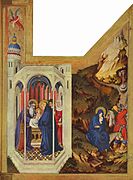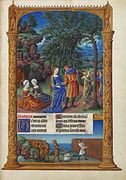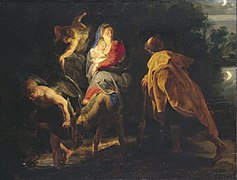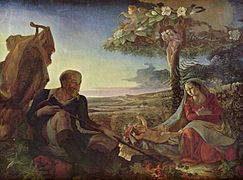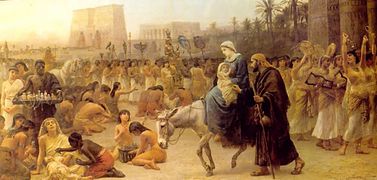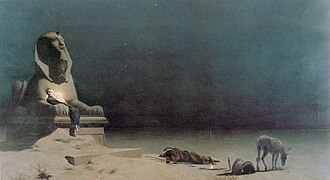Flight into Egypt
canonical gospels |
 |
|
Portals: |
The flight into Egypt is a story recounted in the
Matthew's gospel account

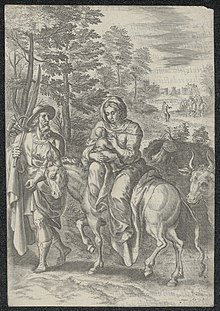
The flight from Herod
When the Magi came in search of Jesus, they went to
Egypt was a logical place to find refuge, as it was outside the dominions of King Herod, but both Egypt and Judea were part of the Roman Empire, linked by a coastal road known as "the way of the sea",[2] making travel between them easy and relatively safe.
Return from Egypt

After a time, the holy family returned from Egypt. The text states that Herod had died. Herod is believed to have died in 4 BC, and while Matthew does not mention how, the Jewish historian Josephus vividly relates a gory death.
The land that the holy family return to is identified as Judah, the only place in the entire New Testament where Judah acts as a geographic description of the whole of
Prophecy of Hosea
Matthew 2:15 cites Hosea 11:1 as prophetically fulfilled in the return of Joseph, Mary and Jesus from Egypt:
"... and out of Egypt I called My son".
Matthew's use of Hosea 11:1 has been explained in several ways. A sensus plenior approach states that the text in Hosea contains a meaning intended by God and acknowledged by Matthew, but unknown to Hosea. A typological reading interprets the fulfillment as found in the national history of Israel and the antitypical fulfillment as found in the personal history of Jesus. Matthew's use of typological interpretation may also be seen in his use of Isaiah 7:14 and 9:1, and Jeremiah 31:15. Thus according to the Ignatius Catholic Study Bible, "Hosea 11.1 points back to the Exodus, where God's 'first-born son' (Ex 4:22), Israel, was delivered from slavery under the oppressive Pharaoh. Matthew sees this text also pointing forward, when Jesus, the eternal first-born Son (Rom 8:29), is delivered from the tyrant Herod and later brought out of Egypt (2:21)."[3] Likewise, The Orthodox Study Bible states that the citation of Hosea 11.1 "refers first to Israel being brought out of captivity. In the Old Testament 'son' can refer to the whole nation of Israel. Here Jesus fulfills this calling as the true Son of God by coming out of Egypt.[4] The Anglican scholar N. T. Wright has pointed out that "The narrative exhibits several points of contact with exodus and exile traditions where Jesus' infancy recapitulates a new exodus and the end of exile, marking him out further as the true representative of Israel."[5]

Another reading of Hosea's prophetic declaration is that it only recounts God summoning of the nation of Israel out of Egypt during the Exodus, referring to Israel as God's son in accordance with Moses' declaration to Pharaoh:
"Israel is my first-born son; let my son go, that he may serve me" (Exodus 4:22–23).
The Masoretic Text reads my son, whereas the Septuagint reads his sons or his children;[6] the Masoretic Text is to be preferred, the singular being both consonant with the other words which are in the singular in Hosea 11:1 and with the reference to Exodus 4:22–23. The Septuagint reading may be explained as having been made to conform to the plurals of Hosea 11:2, they and them.
Historicity
The Gospel of Luke does not recount this story, relating instead that the Holy Family went to the Temple in Jerusalem, and then home to Nazareth.[7] Followers of the Jesus Seminar thus conclude that both Luke's and Matthew's birth and infancy accounts are fabrications.[8][9] A theme of Matthew is likening Jesus to Moses for a Judean audience, and the Flight into Egypt illustrates just that theme.[10]
Regarding Matthew's infancy narrative, the 20th-century British scholar William Neil has said that "when we look beneath the engaging poetic decor, we come face to face with highly probable history. ... The flight of the Holy Family to nearby Egypt until after Herod's death, and the reason for their settling in Galilee on their return, apart altogether from Luke's information that Nazareth was their home, are also circumstantially probable."[11]
In their commentary on Matthew in the
British scholar R. T. France has also argued in support of the historicity of the narrative. "[Joseph's] choice of Egypt as a place of exile ... was in line with the practice of other Palestinians who feared reprisals from the government; as a neighbouring country with a sizeable Jewish population it was an obvious refuge. And his subsequent avoidance of Judea under Archelaus, and expectation of safety in Galilee, accords with the political circumstances as we know them."[13]
Extra-Biblical accounts

Christian
The story was much elaborated in the infancy gospels of the New Testament apocrypha with, for example, palm trees bowing before the infant Jesus, Jesus taming dragons, the beasts of the desert paying him homage, and an encounter with the two thieves who would later be crucified alongside Jesus.[14][15] In these later tales the family was joined by Salome as Jesus' nurse. These stories of the time in Egypt have been especially important to the Coptic Orthodox Church, which is based in Egypt, and throughout Egypt, there are a number of churches and shrines marking places where the family stayed. The most important of these is the Saints Sergius and Bacchus Church, which is claimed to have been built on the place where the family had its home.
One of the most extensive and, in Eastern Christianity, influential accounts of the Flight appears in the perhaps seventh-century Gospel of Pseudo-Matthew, in which Mary, tired by the heat of the sun, rested beneath a palm tree. The infant Jesus then miraculously has the palm tree bend down to provide Mary with its fruit, and release from its roots a spring to provide her with water.[16]
Muslim
The Quran does not include the tradition of the Flight into Egypt, though Al-Muʼminun, 50 could conceivably allude to it: “And we made the son of Maryam and his mother a sign; and we made them abide in an elevated place, full of quiet and watered with springs”. However, its account of the birth of Jesus is very similar to the account of the Flight in the Gospel of Pseudo-Matthew: Mary gives birth leaning against the trunk of a date palm, which miraculously provides her with dates and a stream. It is therefore thought that one tradition owes something to the other.[17][18]
Numerous later Muslim writers on the life of Jesus did transmit stories about the Flight into Egypt. Prominent examples include Abu Ishaq al-Tha'labi, whose ʿArāʾis al-madjālis fī ḳiṣaṣ al-anbiyāʾ, an account of the lives of the prophets, reports the Flight, followed by a stay in Egypt of twelve years; and al-Tabari's History of the Prophets and Kings.[19]
Liturgical commemorations
The
In art

The Flight into Egypt was a popular subject in art, showing Mary with the baby on a donkey, led by Joseph, borrowing the older iconography of the rare Byzantine Journey to Bethlehem. Nevertheless, Joseph is sometimes holding the child on his shoulders.[22] Before about 1525, it usually formed part of a larger cycle, whether of the Nativity, or the Life of Christ or Life of the Virgin.

From the
The background to these scenes usually (until the Council of Trent tightened up on such additions to scripture) included a number of apocryphal miracles, and gave an opportunity for the emerging genre of landscape painting. In the Miracle of the corn, the pursuing soldiers interrogated peasants, asking when the Holy Family passed by. The peasants truthfully said it was when they were sowing their wheat seed; however the wheat has miraculously grown to full height. In the Miracle of the idol a pagan statue fell from its plinth as the infant Jesus passed by, and a spring gushed up from the desert (originally separate, these are often combined). In other less commonly seen legends, a group of robbers abandoned their plan to rob the travelers, and a date palm tree bent down to allow them to pluck the fruit.[24]
During the 16th century, as interest in

A subject taking place after the arrival in Egypt is the meeting of the infant Jesus with his cousin, the infant
The "Flight into Egypt" was a favorite theme of Henry Ossawa Tanner, depicting the Holy Family's clandestine evasion of King Herod's assassins (Matthew 2:12–14). In it Tanner expresses his sensitivity to issues of personal freedom, escape from persecution, and migrations of African-Americans from the South to the North.[26]
Two plays of the medieval Ordo Rachelis cycle contain an account of the flight into Egypt, and the one found in the Fleury Playbook contains the only dramatic representation of the return from Egypt.
In music
The oratorio L'enfance du Christ (1854) by French composer Hector Berlioz relates the events from Herod's dream and his meeting with the Magi through the angels' warning and the flight into Egypt until the Holy Family arrive at Sais.
Two choral works by the German composer Max Bruch take the flight into Egypt as their theme - The Flight of the Holy Family (1863)[27] and The Flight into Egypt (1871).[28]
The German composer Valentin Ruckebier wrote an opera called The Flight To Egypt which was produced and performed in 2021/22 at Teatro Comunale Modena, Linz State Theatre and Serbian National Theatre Novi Sad.[29][30][31]

-
Simple medieval wall painting in a German church in Bochum-Stiepel
-
Burgundy, c. 1400
-
The miracles of the palm tree and corn on the Flight, from a book of hours, ca. 1400
-
miracle of the corn, at top left the falling idol
-
The Flight into Egypt, Adam Elsheimer, c. 1605, as a night scene
-
Rubens, 1614
-
Jan Asselyn, c. 1640
-
Romantic Rest on the Flight by Philipp Otto Runge, 1806
-
British Orientalist artist Edwin Long, Anno Domini, 1883, shows the arrival in Egypt; the idols seem intact.
-
Saint Catherine's Monastery, 12th century
-
Rest on the Flight into Egypt by Luc-Olivier Merson, 1879, Museum of Fine Arts, Boston
-
Statue by Legs F. van Hamme, 17th century
Nazarenes, Nazareth, and Nazirites

While Luke places Jesus' family as being originally from the town of
The difficulty with the brief quote he will be called a Nazarene is that it occurs nowhere in the Old Testament, or any other extant source. The most similar known passage is Judges 13:5 where of Samson it says the child shall be a Nazirite, where a nazirite was a specific type of religious ascetic. That the Nazirite and Nazareth are so similar in name, while Nazareth isn't mentioned in any other source until after the Gospels have been written, and that the passage almost parallels one about the birth of a hero who was a Nazirite, has led many to propose that Matthew originally had Jesus being a Nazirite, but it was changed to Nazarene, inventing a location named Nazareth, when the ascetic requirements fell foul of later religious practices. Biblical scholar R. T. France rejects this explanation, stating that Jesus was not a Nazirite and claiming that he is never described as one.[citation needed]
Another theory is that it is based on a prophecy at Isaiah 11:1, which states there shall come forth a rod out of the stem of Jesse, and a Branch shall grow out of his roots: — the Hebrew for branch is נצר (netzer). The priestly clan of the "netzerites" possibly settled in the place which became known as Netzereth/ Nazareth. Bargil Pixner[34] in his work "With Jesus Through Galilee" says that the title Nazarene, given to Jesus, alludes not so much to his town of origin as to his royal descent. While this piece of wordplay is meaningless when translated into Greek, Hebrew wordplay is not unknown in Matthew, underlining the opinion that some parts of this gospel were originally written in Hebrew.
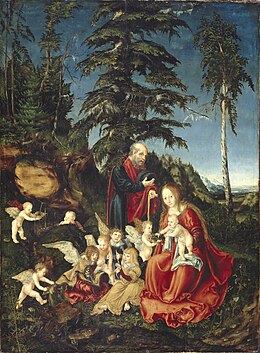
Christian traditions associated with the Flight into Egypt
The Flight into Egypt is one of the listed Seven Sorrows of Mary.
A local French tradition states that
In
Commentary
Justus Knecht notes that the flight shows The Omniscience of God, writing, "God knew that in the morning Herod would send soldiers to Bethlehem, to slay the little boys under two years old; therefore He ordered St. Joseph to flee in the middle of the night. The Lord God knew also the moment of Herod’s death, as well as the evil disposition of his son and successor, Archelaus. He therefore warned St. Joseph not to return to Judaea, but to take up his abode at Nazareth in Galilee."[43]
Roger Baxter reflects on the flight in his Meditations writing, "How different are the thoughts of God from the thoughts of men! Christ was no sooner born, than sent into banishment. The Almighty could easily have rid the world of Herod, or have appeased his anger, or have rendered His divine Son invisible; but He adopted the ordinary means of safety, and His Son must fly. Reflect how derogatory this was to the dignity of the Redeemer, and how full of inconveniences. Thus God always treats those whom He loves best. Are you greater or better than the Son of God? Why, then, do you complain when His providence prepares crosses for you?"[44]
See also
- Chapel of the Milk Grotto
- Exsul Familia
- L'enfance du Christ
- Massacre of the Innocents
- Rest on the Flight into Egypt (Caravaggio)
- Saint Joseph's dreams
- Biblical Egypt
References
- ^ "De vlucht naar Egypte". lib.ugent.be. Retrieved 2020-10-02.
- ^ Von Hagen, Victor W. The Roads that Led to Rome published by Weidenfeld & Nicolson 1967. p. 106.
- ISBN 978-1586174842
- ISBN 978-0718003593
- ISBN 978-0310499305
- ^ Brenton's Septuagint Translation of Hosea 11, accessed 4 December 2016
- ^ Luke 2, v 22–40
- ^ Funk, Robert W. and the Jesus Seminar. The acts of Jesus: the search for the authentic deeds of Jesus. Harper, San Francisco, 1998. "Matthew," pp. 129–270
- ^ Funk, Robert W. and the Jesus Seminar. The acts of Jesus: the search for the authentic deeds of Jesus. Harper, San Francisco. 1998. "Luke", pp. 267–364
- Harris, Stephen L., Understanding the Bible. Palo Alto: Mayfield. 1985. "Matthew" pp. 272–285
- ^ Neil, William (1962). Harper's Bible Commentary. New York: Harper & Row. p. 336.
- ISBN 978-0-3850-8658-5.
- ISBN 0-905774-31-0.
- ^ First Infancy Gospel of Jesus. chapter VIII
- ^ The Gospel of Pseudo-Matthew at The Gnostic Society Library, Christian Apocrypha and Early Christian Literature
- ^ Mustafa Akyol, The Islamic Jesus: How the King of the Jews Became a Prophet of the Muslims (New York: St Martin's Press, 2017), pp. 114-15.
- ISBN 9789004161214.
- ^ Mustafa Akyol, The Islamic Jesus: How the King of the Jews Became a Prophet of the Muslims (New York: St Martin's Press, 2017), pp. 114-16.
- ^ Oddbjørn Leirvik, Images of Jesus Christ in Islam, 2nd ed. (London: Continuum, 2010), pp. 59, 64.
- ^ "СВЯТОЕ СЕМЕЙСТВО - Древо". drevo-info.ru (in Russian). Retrieved 2023-10-02.
- ^ Rock, William (17 February 2023). "The Mass of the Flight into Egypt". fssp.com. Priestly Fraternity of Saint Peter. Retrieved 16 October 2023.
- ^ Terrier Aliferis, L., "Joseph christophore dans la Fuite en Egypte", Zeitschrift für Kunstgeschichte, 2016
- ISBN 0-85331-270-2.
- ^ Schiller:117–123. The date palm incident is also in the Quran. There are two different falling statue legends, one related to the arrival of the family at the Egyptian city of Sotina, and the other usually shown in open country. Sometimes both are shown.
- ^ Catalogued as Baudi di Vesme nos 1–27 (with three plates of frontispiece etc.)
- ^ Flight into Egypt, Henry Ossawa Tanner, Metropolitan Museum of Art
- ^ "Max Bruch". myorchestra.net. MyOrchestra. Retrieved 6 December 2022.
- ^ Prieser, Marcus. "Flight of the Holy Family Op. 20 for choir and orchestra/ Flight into Egypt Op. 31, 1 for soprano, choir and orchestra". repertoire-explorer.musikmph.de. Musikproduktion Hoeflich. Retrieved 8 December 2022.
- ^ "CrossOpera: otherness, fear and discovery". CrossOpera. Retrieved 2022-01-21.
- ^ "Landestheater Linz detail". www.landestheater-linz.at. Retrieved 2022-01-21.
- ^ "CrossOpera: Otherness, fear and discovery, Cinque | Landestheater Linz". Operabase (in German). Retrieved 2022-01-21.
- ISBN 0-06-060037-3.
- ^ Galilee Archived 2006-05-09 at the Wayback Machine.
- ^ Bargil Pixner
- ^ St. Aphrodisius – Catholic Online
- ISBN 9789004161214.
- ^ Egypt voyager
- ^ "Dayr Al-Jarnus". Claremont Coptic Encyclopedia. 1991.
- ^ St Mary Mons
- ^ Coptic Cairo Archived December 14, 2007, at the Wayback Machine
- ^ Commons category; tourist info
- ^ Lapide, Cornelius (1889). The great commentary of Cornelius à Lapide. Translated by Thomas Wimberly Mossman.
- ^ Knecht, Friedrich Justus (1910). . A Practical Commentary on Holy Scripture. B. Herder.
- ^ Baxter, Roger (1823). . Meditations For Every Day In The Year. New York: Benziger Brothers.
Further reading
- The Anchor Bible Series. New York: Doubleday & Company, 1971.
- Brown, Raymond E. The Birth of the Messiah: A Commentary on the Infancy Narratives in Matthew and Luke. New York: Doubleday; London: G. Chapman, 1977. Updated ed. 1993.
- Clarke, Howard W. The Gospel of Matthew and its Readers: A Historical Introduction to the First Gospel. Bloomington: Indiana University Press, 2003.
- France, R.T. The Gospel According to Matthew: an Introduction and Commentary. Leicester: Inter-Varsity, 1985.
- France, R.T. "The Formula Quotations of Matthew 2 and the Problem of Communications." New Testament Studies. Vol. 27, 1981.
- Gabra, Gawdat (ed.). Be Thou There: The Holy Family's Journey in Egypt. Cairo and New York: The American University in Cairo Press, 2001.
- Goulder, M.D. Midrash and Lection in Matthew. London: SPCK, 1974.
- Gundry, Robert H. Matthew a Commentary on his Literary and Theological Art. Grand Rapids: William B. Eerdmans Publishing Company, 1982.
- Jones, Alexander. The Gospel According to St. Matthew. London: Geoffrey Chapman, 1965.
- Schweizer, Eduard. The Good News According to Matthew. Atlanta: John Knox Press, 1975
External links
- Further reading on the Flight into Egypt in art
- John Calvin's commentary on Matthew 2:19
- Orthodox Wiki article on the Flight into Egypt Includes map, info and links to various articles and videos on the subject.


